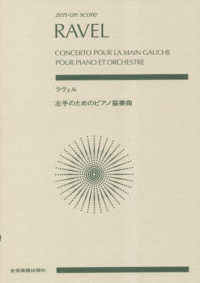Full Description
This handbook provides a comprehensive overview of the history, development, use, and study of the evolving relationship between interpreting and technology, addressing the challenges and opportunities brought by advances in AI and digital tools.
Encompassing a variety of methods, systems, and devices applied to interpreting as a field of practice as well as a study discipline, this volume presents a synthesis of current thinking on the topic and an understanding of how technology alters, shapes, and enables the interpreting task. The handbook examines how interpreting has evolved through the integration of both purpose-built and adapted technologies that support, automate, or even replace (human) interpreting tasks and offers insights into their ethical, practical, and socio-economic implications. Addressing both signed and spoken language interpreting technologies, as well as technologies for language access and media accessibility, the book draws together expertise from varied areas of study and illustrates overlapping aspects of research.
Authored by a range of practicing interpreters and academics from across five continents, this is the essential guide to interpreting and technology for both advanced students and researchers of interpreting and professional interpreters.
Contents
List of Contributors
Acknowledgments
Introduction
Elena Davitti, Tomasz Korybski, and Sabine Braun
Part I: Technology-enabled interpreting
1 Telephone interpreting
Raquel Lázaro Gutiérrez
2 Video-mediated interpreting
Sabine Braun
3 Remote simultaneous interpreting
Agnieszka Chmiel and Nicoletta Spinolo
4 Video relay service
Camilla Warnicke
5 Portable interpreting equipment
Tomasz Korybski
6 Technology-enabled consecutive interpreting
Cihan Ünlü
7 Tablet interpreting
Francesco Saina
Part II: Technology and interpreter training
8 Computer-assisted interpreting (CAI) tools and CAI tools training
Bianca Prandi
9 Digital pens for interpreter training
Marc Orlando
10 Technology for training in conference interpreting
Amalia Amato, Mariachiara Russo, Gabriele Carioli, and Nicoletta Spinolo
Part III: Technology for (semi-)automating interpreting workflows
11 Technology for hybrid modalities
Elena Davitti
12 Machine interpreting
Claudio Fantinuoli
Part IV: Technology in professional interpreting settings
13 Conference settings
Kilian G. Seeber
14 Healthcare settings
Esther de Boe
15 Legal settings
Jérôme Devaux
16 Immigration, asylum and refugee settings
Diana Singureanu and Sabine Braun
Part V: Current issues and debates
17 Quality-related aspects
Elena Davitti, Tomasz Korybski, Constantin Orăsan, and Sabine Braun
18 Ethical aspects
Deborah Giustini
19 Cognitive aspects
Christopher D. Mellinger
20 International and professional standards
Veronica Pérez Guarnieri and Haris Ghinos
21 Workflows and working models
Anja Rütten
22 Ergonomics and accessibility
Wojciech Figiel
Index








